Understanding the Future of the Internet of Behavior (IoB)
What is Internet of Behavior?

How it works?
Advantages of Internet Behavior
The IoB can provide a more personalized experience for users by collecting and analyzing data on their behavior and preferences, allowing companies to tailor their products and services to individual needs.
By analyzing data on user behavior, the IoB can identify patterns and trends that can be used to optimize processes and systems, resulting in improved efficiency and productivity.
The IoB can be used to identify potential security threats and take preventive measures before they can cause harm.
The insights gained from IoB data can be used to make better-informed decisions, such as adjusting marketing strategies, optimizing business processes, and improving customer satisfaction.
IoB technologies can be used to monitor and analyze patient behavior and provide personalized healthcare services, resulting in better health outcomes.
The IoB can be used to create smart cities that use data to optimize resource allocation, improve traffic flow, and reduce energy consumption.
What could be the challenges for IoB?
One of the biggest challenges with IoB is the collection and use of personal data. As IoB systems rely on the collection of data on user behavior, there are concerns around privacy and data protection.
IoB systems have the potential to be used for unethical purposes, such as manipulating user behavior or infringing on their rights. As such, it is important to ensure that ethical considerations are taken into account when designing and implementing these systems.
The IoB can be used to identify potential security threats and take preventive measures before they can cause harm.
Integrating IoB systems with existing infrastructure and platforms can be challenging, particularly for legacy systems.
Ensuring the accuracy of the data collected by IoB systems is critical to their effectiveness. Inaccurate data can lead to poor decision-making and ineffective recommendations.
IoB systems may face resistance from users who are concerned about privacy and data protection. Ensuring that users understand the benefits of these systems and how their data is being used is critical to their adoption and success.
conclusion
Testimonial
Work Well Together

“We have been working with Arjun and Pritesh for more than a year now and they completely meet our expectations. We quickly found a way to effectively work together despite the time difference. They are flexible and proactive, they get to the bottom of things and deliver high quality code."
Camille
It's been a pleasure to collaborate with Rushi. Clean code, well documented, excellent communication. Looking forward to our ongoing collaboration.
George
ZenTech offers a hard working team. They understand the requirements well and follow them thoroughly. They have good knowledge of python and django and had a good contribution to my project.
EdoOur Client
















